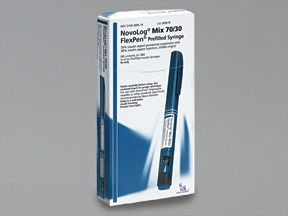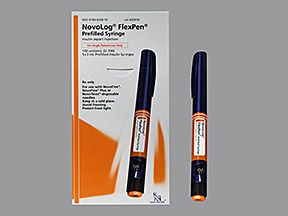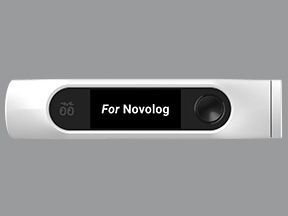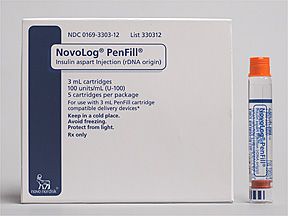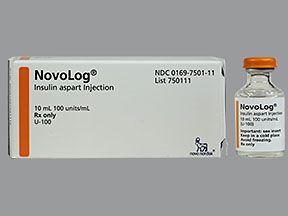If you have diabetes, your doctor may discuss NovoLog as a treatment option for you.
NovoLog is a prescription medication that’s used to treat type 1 or type 2 diabetes. Specifically, it helps manage blood sugar levels in adults and some children with these conditions.
NovoLog’s active ingredient is insulin aspart. An active ingredient is what makes a drug work. It belongs to a group of drugs known as rapid-acting insulins. NovoLog is a biologic medication, which means it’s
NovoLog comes as a solution for injection. You can give yourself NovoLog as an injection under your skin. In some cases, a healthcare professional may give NovoLog as an intravenous (IV) infusion (an injection into your vein given over time).
This article describes the dosages of NovoLog, as well as its strengths and how to use the drug. To learn more about NovoLog, see this in-depth article.
Note: This article covers general dosing information for NovoLog. But when using NovoLog, always take the dosage that your doctor prescribes.
This section provides general dosage information about NovoLog. Always follow your doctor’s guidance on the correct dosage for you.
What are the forms of NovoLog?
NovoLog comes as a solution for injection. It’s available in different forms, such as the FlexPen device, for dosing. The chart below describes these forms. Each form listed below contains multiple doses of insulin.
| NovoLog form | Description | Size in milliliters (mL) |
| NovoLog vial | vial that can be used for injections under the skin or infusions into a vein, as well as with insulin pumps | 10 mL |
| NovoLog FlexPen* | disposable, prefilled insulin pen for injections under the skin | 3 mL |
| NovoLog PenFill | disposable, prefilled cartridge for injections under the skin | 3 mL |
* The manufacturer of NovoLog used to offer a prefilled pen called FlexTouch, but FlexPen has replaced that form.
Your doctor can provide more information about the pros and cons of each dosage form.
What strength does NovoLog come in?
NovoLog comes in a strength of U-100. This means it contains 100 units of insulin per 1 milliliter (mL) of solution.
What are the usual dosages of NovoLog?
Your doctor will ultimately prescribe the smallest dosage of NovoLog that will manage your blood sugar levels.
The manufacturer of NovoLog doesn’t provide specific dosage recommendations, a dosage calculator, or maximum dose information for NovoLog. Your dosage will depend on whether you have type 1 or type 2 diabetes, as well as your blood sugar levels, weight, diet, and other factors.
When you first start using NovoLog, your doctor will calculate your dosage according to these factors. They’ll show you how to adjust your dosage based on these factors and any changes to your diet.
Your doctor will also demonstrate how to give yourself a dose. For more information, see the “How is NovoLog given?” section below.
As a general recommendation for type 1 diabetes, the American Diabetes Association (ADA) suggests a daily dose of 0.4 units to 1 unit of insulin per kilogram (kg)* of body weight. Half of that amount should be an intermediate or long-acting insulin. The other half should be a rapid-acting insulin, such as NovoLog.
You’ll divide your NovoLog dose throughout the day, taking it 5 to 10 minutes before meals.
For type 2 diabetes, a typical starting dose for NovoLog is 4 units with your largest meal. Your doctor will likely adjust the dose and frequency of NovoLog based on your blood sugar levels.
Be sure to follow the dosage instructions your doctor gives you. They’ll determine the best dosage to fit your needs.
* One kg is equal to about 2.2 pounds.
What’s the dosage of NovoLog for children?
NovoLog is used to manage blood sugar levels in children ages 2 years and older who have type 1 or type 2 diabetes. Your child’s doctor will calculate the dosage of NovoLog for your child based on the type of diabetes they have, as well as their age, weight, and other factors.
The manufacturer of NovoLog doesn’t provide specific dosing recommendations for children. The general insulin dosage guidelines from the ADA for children is the same as for adults, as described in the section just above.
For more information about the right dosage of NovoLog for your child, talk with their doctor.
Is NovoLog used long term?
Yes, NovoLog is usually used as a long-term treatment. If you and your doctor determine that NovoLog is working to manage your blood sugar levels safely, you’ll likely use it long term.
Dosage adjustments
If you have liver or kidney problems, you may have a greater risk of low blood sugar levels. As a result, you may need adjustments to your NovoLog dosage. Tell your doctor about any liver or kidney problems you have. This will help them determine the right NovoLog dosage for you.
Below are answers to some commonly asked questions about NovoLog’s dosage.
What’s a NovoLog sliding scale?
A sliding scale is a chart that provides insulin dosing ranges for each meal. The ranges are based on factors such as a person’s blood sugar levels.
Your doctor may recommend a NovoLog sliding scale. If so, they’ll provide dosing ranges on your sliding scale that account for your diet, how much you exercise, medications you may take, and other factors.
If you have questions about the best way to figure out your dosage, talk with your doctor.
Is the dosage for NovoLog the same as for NovoLog Mix 70/30?
No. Their names may be similar, and they both come in some of the same forms, such as the FlexPen. But your dosage of NovoLog Mix 70/30 would not be the same as your dosage for NovoLog. It’s important to note that these products are different, so they are not interchangeable.
NovoLog is a rapid-acting insulin. You’ll give yourself a dose 5 to 10 minutes before a meal, and its effects typically last 3 to 5 hours.
NovoLog Mix 70/30 is a combination of rapid-acting and intermediate-acting insulin. Usually, you’ll give yourself a dose 15 minutes before a meal. The effects of a dose of NovoLog Mix 70/30 last longer than NovoLog, up to 24 hours.
If you’re prescribed NovoLog Mix 70/30, talk with your doctor about the dosage that’s right for you.
How do I determine my correction dose for NovoLog?
Your doctor will show you how to calculate your NovoLog correction dose. This depends on individual factors.
An insulin correction dose is the amount of extra insulin you’ll need to “correct” a high blood sugar level. You take the extra insulin to help decrease your blood sugar to a certain level (referred to as your target level).
For more information about your NovoLog correction dose, talk with your doctor.
How does NovoLog’s dosage compare with Humalog’s?
Both NovoLog and Humalog are rapid-acting insulins used by people with type 1 or type 2 diabetes. NovoLog works slightly faster than Humalog.
NovoLog and Humalog are not interchangeable. But their dosing will be based on similar factors, such as your age, other medications you’re taking, and your blood sugar levels.
Your doctor will recommend the kind of insulin and dosage that’s best suited to manage your blood sugar levels.
To learn more about the similarities and differences between NovoLog and Humalog, see this article.
The dosage of NovoLog you’re prescribed may depend on several factors. These include:
- the type and severity of the condition you’re using NovoLog to treat
- your age
- your weight and diet
- how much you exercise
- any medications that you take
- how responsive your body is to insulin
- other conditions you may have (see “Dosage adjustments” under “What is NovoLog’s dosage?”)
NovoLog comes as a solution for injection. You’ll likely give yourself NovoLog as an injection under your skin. When you first begin using NovoLog, your doctor will show you how to do this. You can also get NovoLog dosing instructions on the manufacturer’s website.
In certain situations, a healthcare professional can give NovoLog as an intravenous (IV) infusion (an injection into a vein given over time).
You’ll divide your NovoLog dose throughout the day, taking it 5 to 10 minutes before meals. Before receiving your dose of NovoLog, always check to make sure the solution is clear or colorless.
You’ll need separate supplies to use NovoLog, depending on the dosage form your doctor prescribes. Supplies include pen needles, syringes, and insulin pumps. Your doctor or pharmacist can discuss which supplies you’ll need and how to get them.
For information on NovoLog expiration, storage, and disposal, see this article.
Accessible drug containers and labels
If you find it hard to read the prescription label on your medication, tell your doctor or pharmacist. Some pharmacies may provide medication labels that:
- have large print or use braille
- feature a code that you can scan with a smartphone to change the text to audio
Your doctor or pharmacist may be able to recommend pharmacies that offer these accessibility features if your current pharmacy doesn’t.
You’ll likely give yourself NovoLog around mealtimes. If you miss a dose of NovoLog before eating, you can take your dose during the meal. But if you’ve finished your meal, check your blood sugar level to determine whether you need to take your missed dose. If you aren’t sure, check with your doctor.
Changing your dosing schedule of NovoLog can affect your blood sugar levels. Monitor your blood sugar carefully until your next regularly scheduled dose.
If you’re worried about a missed dose, contact your doctor. They can discuss what to do based on your blood sugar levels.
If you need help remembering to take your dose of NovoLog on time, try using a medication reminder. This can include setting an alarm or downloading a reminder app on your phone.
Do not use more NovoLog than your doctor prescribes. Using more than this can lead to serious side effects.
Symptoms of overdose
An overdose of NovoLog can cause very low blood sugar. Symptoms include:
A NovoLog overdose may also cause a low level of potassium in the blood. Symptoms include:
What to do in case you use too much NovoLog
Call your doctor right away if you think you’ve used too much NovoLog. You can also call 800-222-1222 to reach the American Association of Poison Control Centers or use its online resource. But if you have severe symptoms, call 911 (or your local emergency number) immediately or go to the nearest emergency room.
The sections above give general information about NovoLog’s dosages. If your doctor recommends NovoLog for you, they’ll prescribe the dosage that’s right for you.
Remember, you should not change your dosage of NovoLog without your doctor’s recommendation. Only use NovoLog exactly as prescribed. Talk with your doctor if you have questions or concerns about your current dosage.
Here are a few questions you may want to ask them:
- Will my dosage of NovoLog change if I’m using NovoLog FlexPen versus PenFill?
- How does my lifestyle affect my NovoLog dosage?
- Does my NovoLog dosage change if I start taking other medications for my condition?
If you have type 2 diabetes, you can find support and advice from others by joining the Bezzy T2D community. You can also get tips for managing your condition from Healthline’s diabetes newsletter.
Q:
Will my dosage of NovoLog stay the same or change over time?
AnonymousA:
Your dosage depends on several factors. These include your blood sugar levels, how you respond to insulin, and any other medications you take. It also depends on lifestyle factors such as how much you exercise and what you eat.
In some cases, your doctor may prescribe a range for your NovoLog dose. The exact amount that you take within the range may vary with each meal based on your blood sugar levels and carbohydrate intake.
In other cases, your doctor may prescribe a set dose of NovoLog for each meal. They may need to adjust the set dose over time depending on how your blood sugar levels respond.
To avoid major shifts in your blood sugar levels, talk with your doctor about your NovoLog dosage. They can let you know whether you need dosage changes.
The Healthline Pharmacist TeamAnswers represent the opinions of our medical experts. All content is strictly informational and should not be considered medical advice.Disclaimer: Healthline has made every effort to make certain that all information is factually correct, comprehensive, and up to date. However, this article should not be used as a substitute for the knowledge and expertise of a licensed healthcare professional. You should always consult your doctor or another healthcare professional before taking any medication. The drug information contained herein is subject to change and is not intended to cover all possible uses, directions, precautions, warnings, drug interactions, allergic reactions, or adverse effects. The absence of warnings or other information for a given drug does not indicate that the drug or drug combination is safe, effective, or appropriate for all patients or all specific uses.

